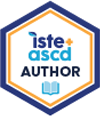
Event Information

1. Welcome, presenter introduction - 3 minutes
2. Description of the educational context in which the presenter works (i.e. students and community). Identifying the challenge: Structuring culturally relevant learning opportunities to foster a sense of belonging and the development of cultural literacy. - 5 minutes
3. The presenter will discuss the hallmarks of culturally responsive instruction and explain how digital storytelling (in particular, moviemaking) exemplifies this instructional approach. The presenter will share research to connect storytelling to brain science, equity frameworks, ISTE Standards, and Transformative Learning Principles. - 5 minutes
4. The presenter will showcase culturally relevant moviemaking projects and explain how to effectively integrate them in any classroom. Featured replicable projects include the "I Am" cultural poem project to introduce the concept of storytelling and the "Best Part of Me" project to build belonging. Student samples were created by Filipino and Latinx students. Both of these projects can be used for personal expression to build community and share cultural background. - 10 minutes
5. The presenter will explain how moviemaking can function as a tool to build empathy both within and outside of specific cultural groups. (Similar to the concept of utilizing texts as windows, mirrors, and sliding glass doors.) They will share the "In My Time" replicable moviemaking lesson frame and how it can be used to lift under-represented voices. Includes several student-created examples pertaining to Black History Month, Native American Heritage Month, and Hispanic Heritage Month. Next, the presenter will share the culturally relevant "Where I'm From" movie project and show several examples created by Latinx students, as well as the impact these projects had on classroom culture. - 15 minutes
6. The presenter will showcase the "Personal Story" project, including examples created by students from a variety of backgrounds. This portion of the presentation will focus heavily on allowing students to find and develop messages they want to broadcast into the world to communicate their learning, affect change, and/or share their lived experiences. Student examples in this portion were created by Latinx and African-American students. - 10 minutes
7. Presenters discuss how teachers can scaffold storytelling for success in the classroom. This includes tips for how to begin the storytelling process, common pitfalls to avoid, and how to scaffold for success for all students. - 10 minutes
8. Closing and additional resources. - 2 minutes
Pack, Jessica (2021). Moviemaking in the Classroom: Lifting Student Voices Through Digital Storytelling.
Pack, J. (2023, November 13). Supporting student identity development through moviemaking. Edutopia. https://www.edutopia.org/article/supporting-student-identities-moviemaking
Pack, J. (2024, January 29). Teaching students how to make movies to document their learning. Edutopia. https://www.edutopia.org/article/teaching-moviemaking-high-school
Boryga, A. (2023, June 9). How school culture must change, post-pandemic. Edutopia. https://www.edutopia.org/article/how-school-culture-must-change-post-pandemic/
Briant, K. J., Halter, A., Marchello, N., Escareño, M., & Thompson, B. (2016, November). The power of digital storytelling as a culturally relevant health promotion tool. Health promotion practice. Retrieved September 28, 2022, from https://www.ncbi.nlm.nih.gov/pmc/articles/PMC5065376/
Gallo, C. (2019). Storytelling to Inspire, Educate, and Engage. American Journal of Health Promotion, 33(3), 469–472. https://doi.org/10.1177/0890117119825525b
Will, M., & Najarro, I. (2022, May 10). What is culturally responsive teaching? Education Week. Retrieved September 28, 2022, from https://www.edweek.org/teaching-learning/culturally-responsive-teaching-culturally-responsive-pedagogy/2022/04
Peterson, L. (2018, October 17). The Science Behind The Art Of Storytelling. Harvard Business Publishing: Corporate Learning. https://www.harvardbusiness.org/the-science-behind-the-art-of-storytelling/.
Vu, V., Warschauer, M., & Yim, S. (2019). Digital Storytelling: A District Initiative for Academic Literacy Improvement. Journal of Adolescent & Adult Literacy, 63(3), 257-267. https://doi.org/10.1002/jaal.962
Zak, P. J. (2013, December 13). How Stories Change the Brain. Greater Good Magazine. https://greatergood.berkeley.edu/article/item/how_stories_change_brain.

